Updated December 2023: Removed the Puuko knife.
Do you know what’s often at the core of bushcraft…a good bushcraft knife.
But how do you know if you’re getting a good bushcraft knife? And what should you be looking for when you’re shopping?
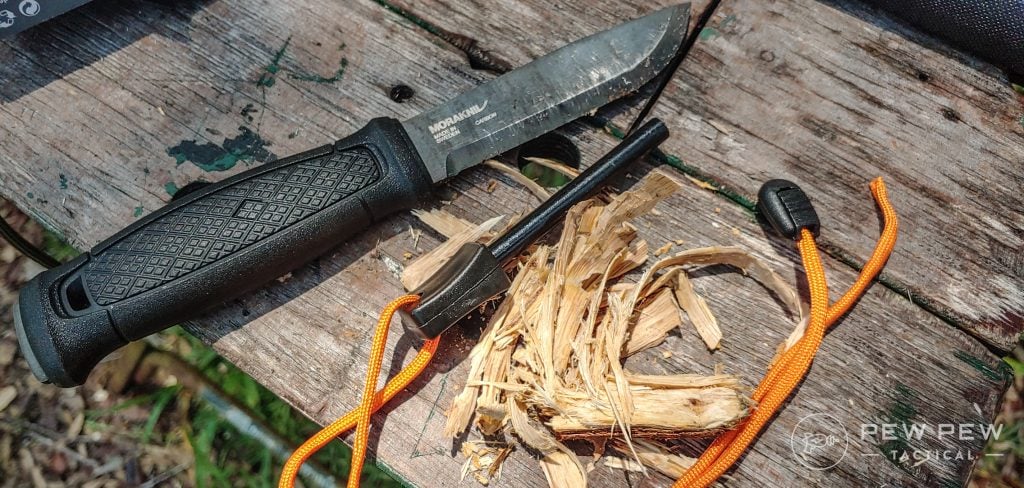
No worries, I got you covered.
I’m going to walk you through what bushcrafting is (and how it differs from survival), why you need a bushcraft knife, and what qualities make one good or not so good, and list out some knives I recommend.
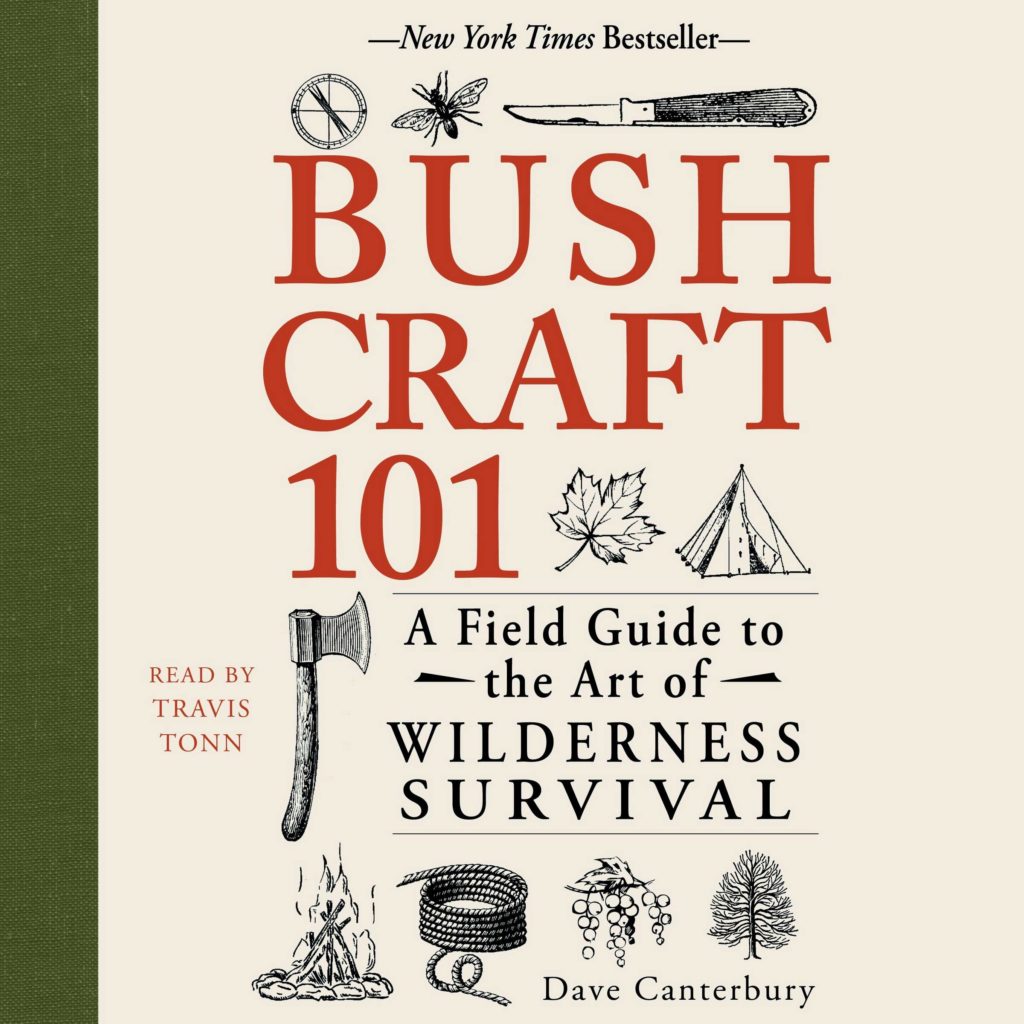
By the end, you should have a better understanding of what to watch out for when you’re on the hunt for a new bushcraft knife.
So keep reading…
THE QUICK LIST
-
Editor’s Pick
-
Most Comfortable
-
Best Budget Knife
-
Most Versatile
-
Runner Up Budget Pick
-
Best Traditional Bushcraft Knife
Table of Contents
Loading…
Why You Should Trust Us
I’ve spent a lifetime shooting that started in a family that hunted every season they legally could. From there, I joined the United States Marine Corps and spent five years as an infantryman.
In the middle of my Marine Corps career, I began writing and have never stopped. I soon earned my NRA instructor certification.
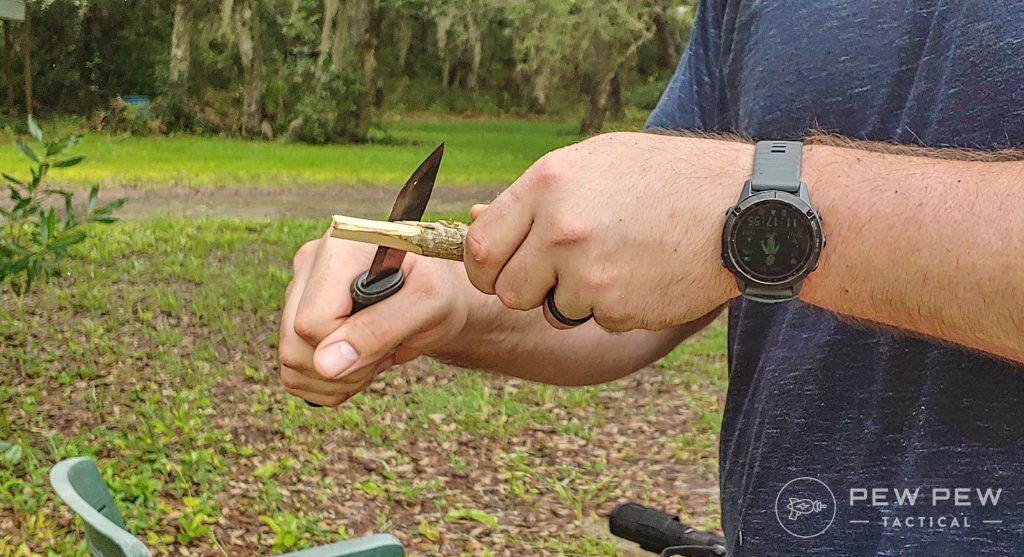
I love guns, but I also love knives and most recently got into bushcrafting. I’m a continual student, and I strive to educate myself to provide the best information possible to the readers of Pew Pew Tactical.
We constantly test gear and regularly update articles as new models become available, so if you’re favorite isn’t here, check back soon!
Best Overall Bushcraft Knives
1. Morakniv Garberg
Prices accurate at time of writing
Prices accurate at time of writing
-
25% off all OAKLEY products - OAKLEY25
Copied! Visit Merchant
Pros
- Perfectly square spine
- Comes in both carbon and stainless steel blades
Cons
- Pricier
Swedish company Morakniv has produced knives for well over a century.
Morakniv designs started for lumber use and eventually evolved into a very successful line of bushcraft knives.
The Garberg combines the winning Morakniv design with a full tang.
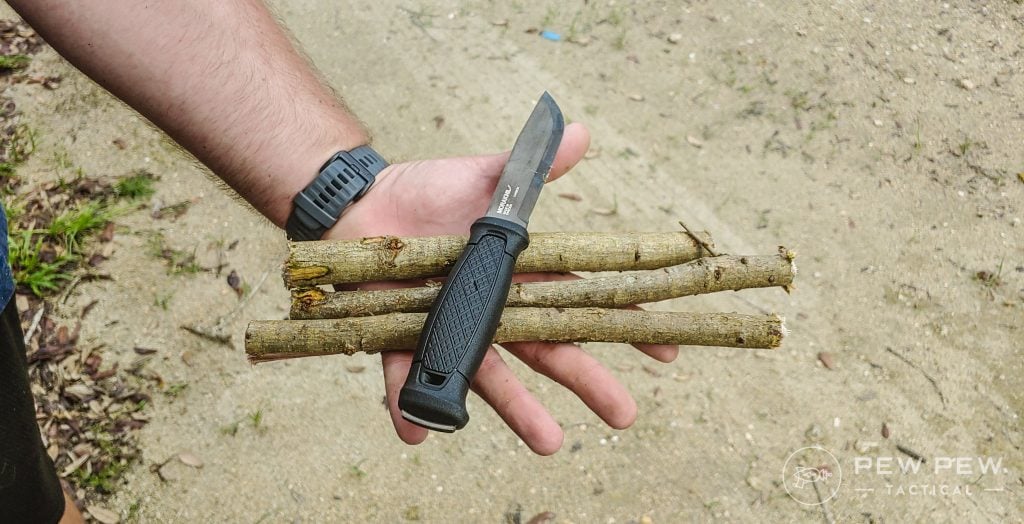
Users get a perfectly squared spine for striking Ferro Rods with ease.
The blade comes in either carbon steel or stainless steel, so you can choose which setup you want.
With a 4.25-inch long blade, the Garberg provides plenty of Scandi grind blade for cutting and slicing. You can carve, whittle, and drill with the clip-point blade rather easily.
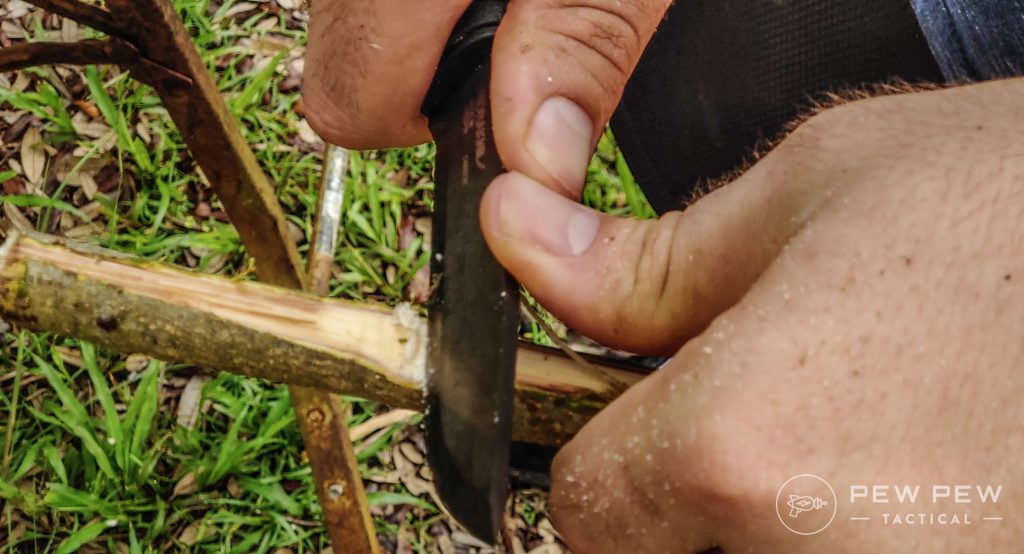
The ultra-awesome handle is super comfortable, with a good bit of grip texture that combines comfort and safety while you work.
Plus, the multi-mount sheath rocks for various uses.
Best Comfortable Bushcraft Knives
2. L.T. Wright GNS
Prices accurate at time of writing
Prices accurate at time of writing
-
25% off all OAKLEY products - OAKLEY25
Copied! Visit Merchant
Pros
- Great steel
- Versatile blade design
- Comfortable grip
Cons
- Poor corrosion resistance
L.T. Wring is a knife designer who focuses largely on bushcraft blades.
His designs are among some of the best for bushcraft purposes, and the GNS is the flagship of the knife company and has all the features Mr. Wright prefers.
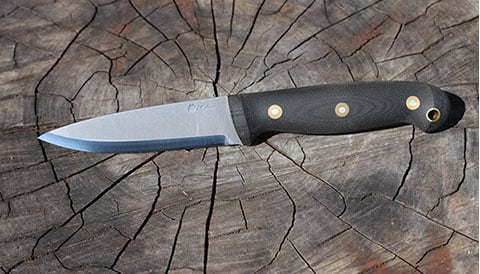
It offers a Scandi grind, a centerline point, and a squared spine. Not to mention, the 4.25-inch blade is plenty of knife for bushcraft use.
The combination makes the GNS an excellent tool for making tools. Its blade is made from O1 tool steel — premium-grade steel for bushcraft needs.
O1 steel is easy to sharpen and holds a good edge. It’s extremely strong and very capable.
The downside comes down to its poor corrosion resistance. Other than that, it’s a great choice.
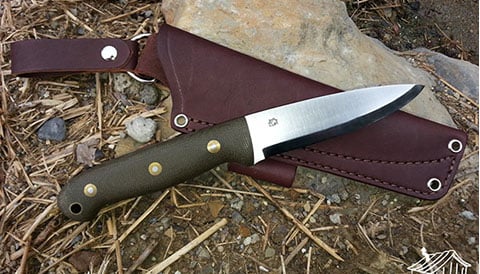
It’s a simple knife that makes it easy to feather sticks, create bow drill holes, whittle, and beyond.
The micarta grips give you a comfortable and well-textured design for hours and hours of work.
Best Budget Bushcraft Knives
3. Condor Tool and Knife Bushlore Camp Knife
Prices accurate at time of writing
Prices accurate at time of writing
-
25% off all OAKLEY products - OAKLEY25
Copied! Visit Merchant
Pros
- Affordable price point
- Tough blade
- Scandi edge
Cons
- Doesn't hold edge as well as others
If you want something a little more affordable than most, the Condor Tool and Knife Bushlore Camp is a great starter.
Maybe you want to experiment a bit with some backyard bushcrafting…the Bushlore Camp Knife is perfect for learning.
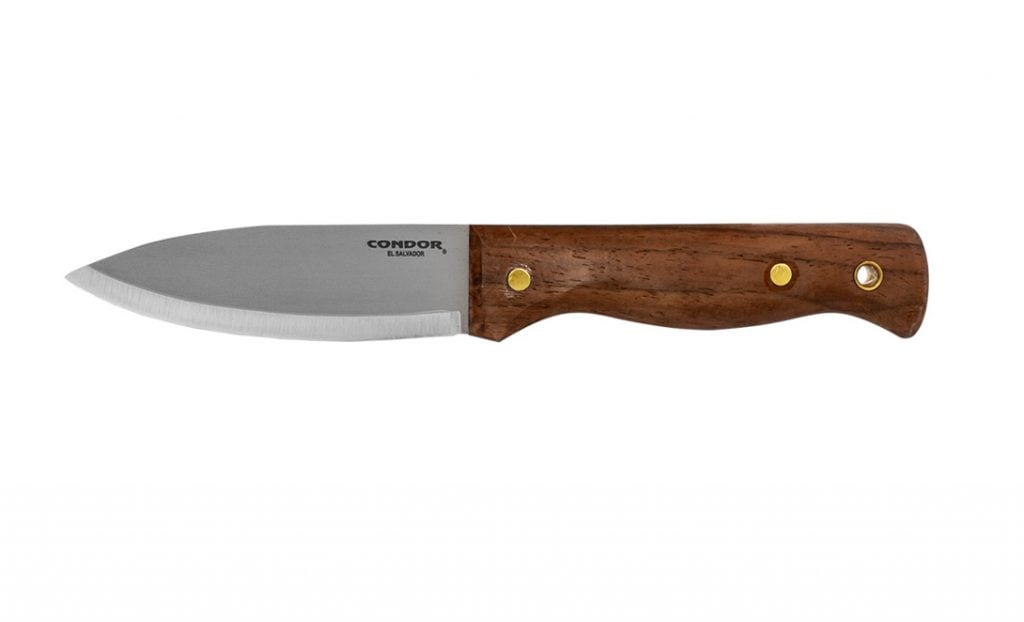
We get a 1075 high carbon steel blade that measures about 4.25 inches long. Admittedly, 1075 isn’t the best steel for any particular use, but it’s tough, and tough is important.
It doesn’t hold an edge as well as other steels, but again, it’s a great beginner option.
When you want a good grind, it’s tough to beat the Scandi grind used on the Condor Bushlore. It’s a grind you’ll constantly see on high-end bushcraft knives.
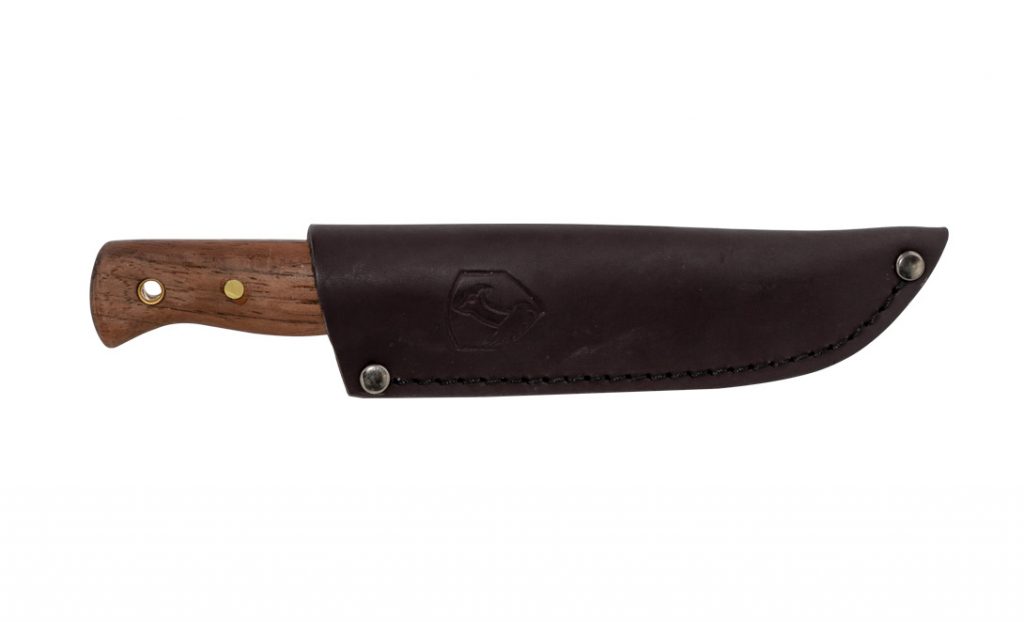
Beyond the blade, the Bushlore Camp Knife offers you a centerline point for easy drilling and digging-like tasks.
The comfortable wood handle looks nice and feels good in the hand but lacks a good grip texture for use with gloves.
Most Versatile Bushcraft Knives
4. ESEE 4
Prices accurate at time of writing
Prices accurate at time of writing
-
25% off all OAKLEY products - OAKLEY25
Copied! Visit Merchant
Pros
- Choice of stainless or carbon steel
- Extremely versatile
- Rugged design
Cons
- Expensive
When it comes to favoritism and bias, the ESEE-4 gets mine full stop.
I love the ESEE-4, and it’s my current go-to bushcraft knife for sharpening my skills (pun intended).
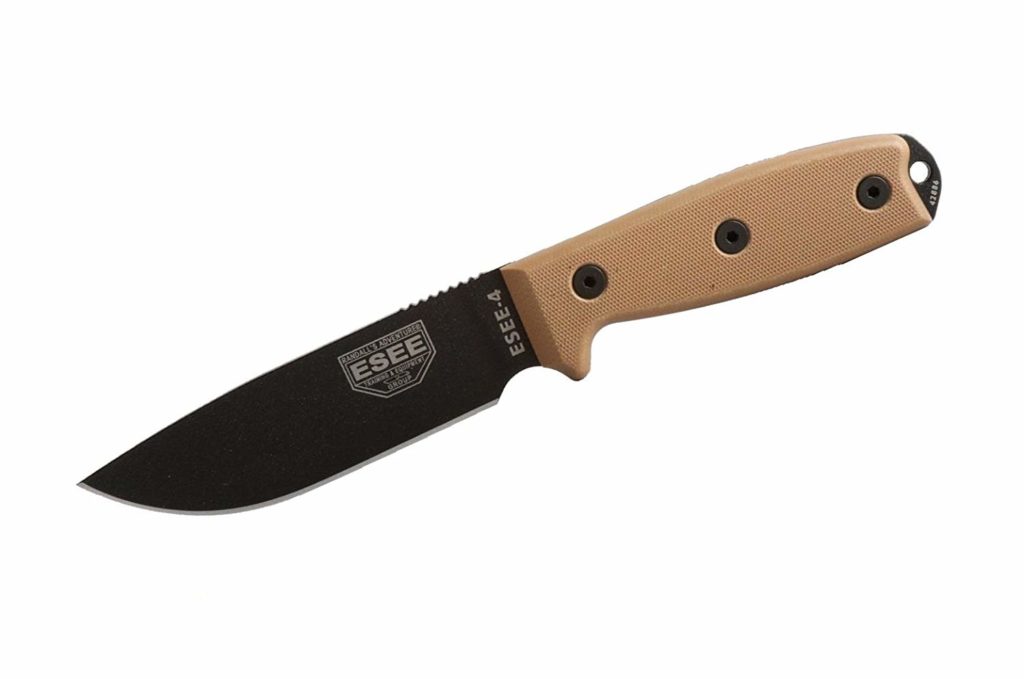
Randall’s Adventure company designs the ESEE series knives, and those cats are experienced bushcrafters, survivalists, and adventurers. Their knives reflect their experience.
The ESEE-4 packs a 4.5-inch blade in either 440C stainless steel or 1095 carbon steel, so buyers have options.
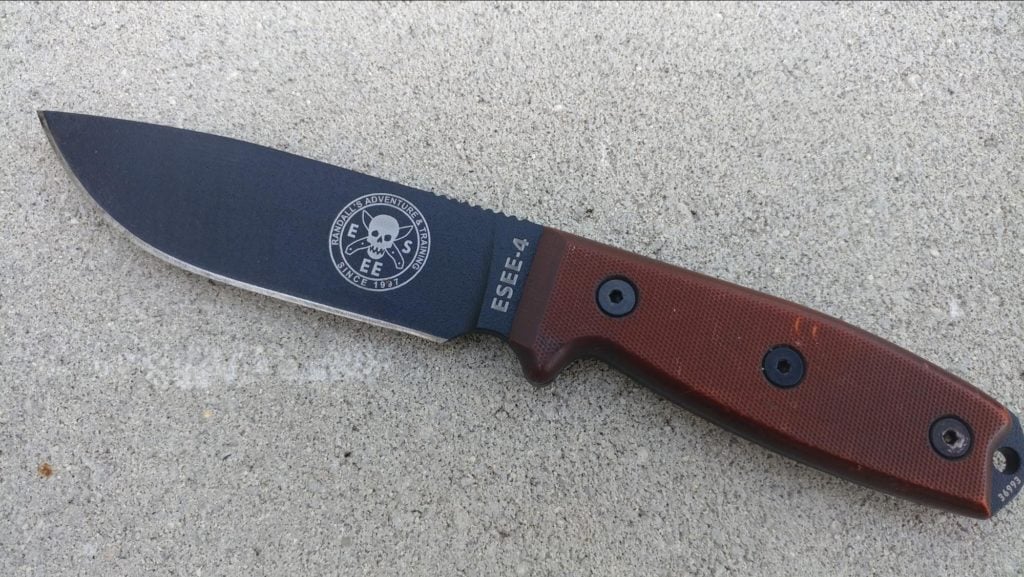
Beyond that, the blade is ruggedly simple and quite robust.
Both materials provide a very strong, capable blade. It’s topped with a simple but versatile drop-point blade with a healthy belly for deep cuts.
The ESEE-4 comes with rounded G-10 handles that are textured and aggressive for a sure grip. Yet, they aren’t too highly textured to cause discomfort.
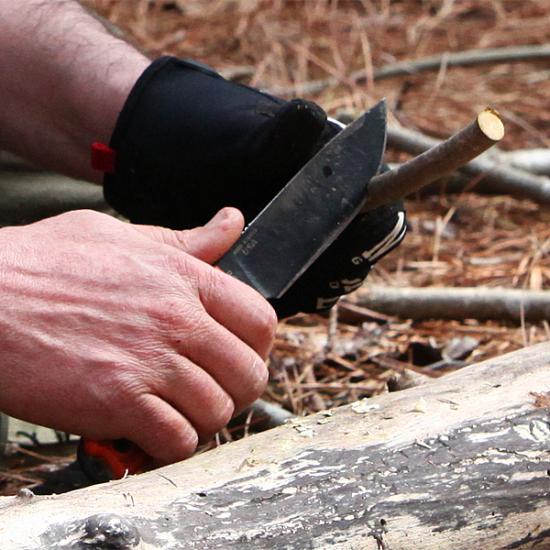
It’s one of my favorite knives and is a great all-around knife for survival, bushcrafting, fishing, hunting, and more.
What do you think of the ESEE-4? Give it a rating below.
Runner Up for Best Budget Bushcraft Knives
5. Ontario Bushcraft Field Knife
Prices accurate at time of writing
Prices accurate at time of writing
-
25% off all OAKLEY products - OAKLEY25
Copied! Visit Merchant
Pros
- Affordable design
- Great budget steel
- Larger 5-inch blade
Cons
- Not as corrosion resistant
Another good budget option for bushcrafting comes from the Ontario Knife Company.
The Bushcraft Field Knife combines lots of classic bushcraft features that give you a lot for only a little bit of money.

It’s a little big with its 5-inch blade, but still fits the bushcraft role. The blade is made from 5160, which is one of the better budget knife steels.
This knife holds a good edge, feels quite tough, and can get quite sharp. It suffers in the corrosion resistance department, so make sure you keep knife oil on hand.
The saber grind is second only to the Scandi grind for bushcraft knives. It’s a smart design for the Ontario Bushcraft Field Knife.

It improves the knife’s versatility and makes it equal parts butcher knife for dressing game and field knife for bushcrafting.
A set of walnut handles gives it a distinct look and feel but doesn’t provide much texture for grip-challenging conditions.
It will chop, cut, and glide through various materials, and you’ll have no problems batoning wood with the bigger, heavier blade.
Best Traditional Bushcraft Knives
6. KA-BAR Becker Kephart
Prices accurate at time of writing
Prices accurate at time of writing
-
25% off all OAKLEY products - OAKLEY25
Copied! Visit Merchant
Pros
- Designed by the father of bushcrafting
- Large blade
- Easy to sharpen
Cons
- Prone to rust
Most bushcrafters consider Horace Kephart the father of modern bushcrafting and revere him as such. He designed the original Kephart knife — the perfect woodcraft tool.
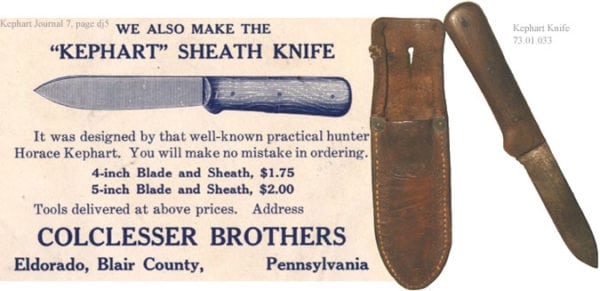
KA-BAR replicated the Kephart knife. This version wears a long 5.125-inch blade with a centerline drop-point tip. This is a versatile tool for drilling holes and whittling with ease.
A healthy belly provides plenty of chopping and cutting room for bushcrafters.

It’s a practical knife for bushcraft and allows you to craft tools, construct shelters, and skin game without much stress.
Heck, the spine is even square enough to strike fire rods with relative ease. Also, it can be used to baton wood without much difficulty.
KA-BAR utilizes 1095 Cro-Van steel.
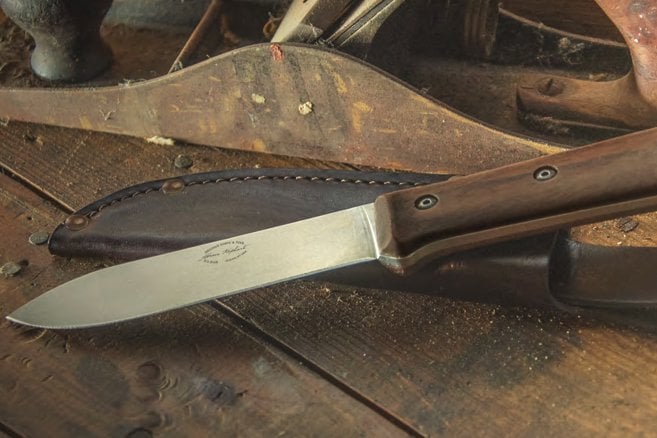
This steel can get super sharp and is actually even easy to sharpen — surprisingly tough and very hard.
The biggest downside would be its corrosion resistance. It’s prone to rust, so keep it oiled after use.
Best Bushcraft Knives Comparison Chart
| Knife | Price | Overall Length | Blade Length | Steel Type | Sheath | Weight |
|---|---|---|---|---|---|---|
| Morakniv Garberg | $60 | 9.0″ | 4.3″ | Stainless Steel | Leather | 9.6oz |
| L.T. Wright GNS | $180 | 9.5″ | 4.5″ | 01 Tool Steel | Leather | 7.78oz |
| Condor Tool & Knife Bushlore Camp | $62 | 9.25″ | 4.25″ | 1075 High Carbon Steel | Leather | 0.8lb |
| ESEE-4 | $124 | 9.0″ | 4.50″ | 1095 | Polymer | 8oz |
| Ontario Bushcraft Field | $71 | 10.25″ | 5.0″ | 420 High Carbon Satinless Steel | Nylon belt sheath | 0.6lb |
| Ka-Bar Becker Kephart | $158 | 9.625″ | 5.125″ | 1095 Crow Van Carbon Steel | Leather | 0.4lb |
What Is Bushcraft
My journey with bushcrafting started as just trying to learn what I thought were general outdoor survival skills.
As I got deeper and deeper into the hobby and skillset, I found I was learning bushcraft techniques…not just survival tips.
So what’s the difference between survival and bushcraft?
Think of survival skills as the bare minimum… the baby steps to bushcraft.
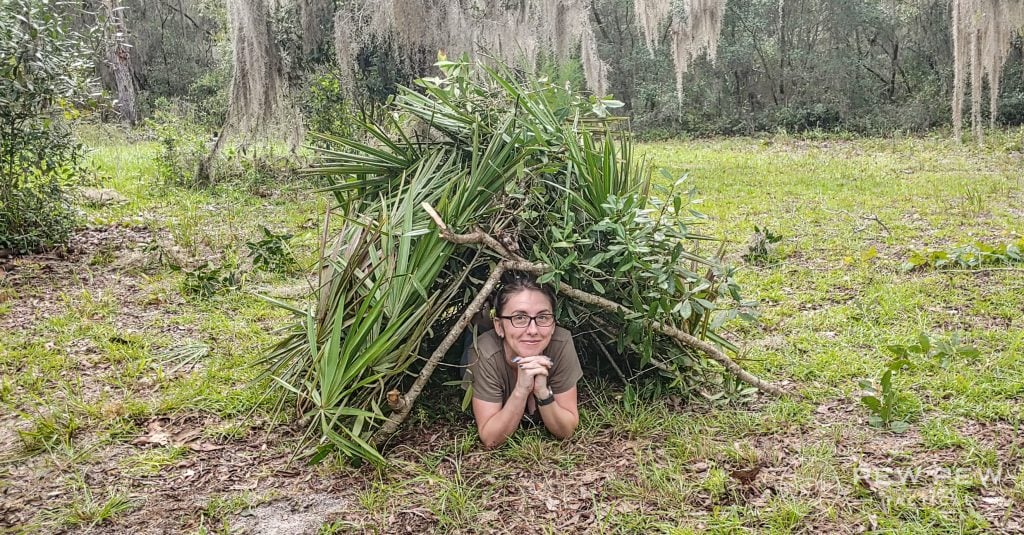
Bushcraft goes beyond survival.
It uses some of the same skills, like building shelter and starting fires, but pushes it further than the basics.
This style often relies on primitive skills used by early men that can be used long-term.
A person with great bushcraft skills can just go in the woods and live for an unspecified amount of time.
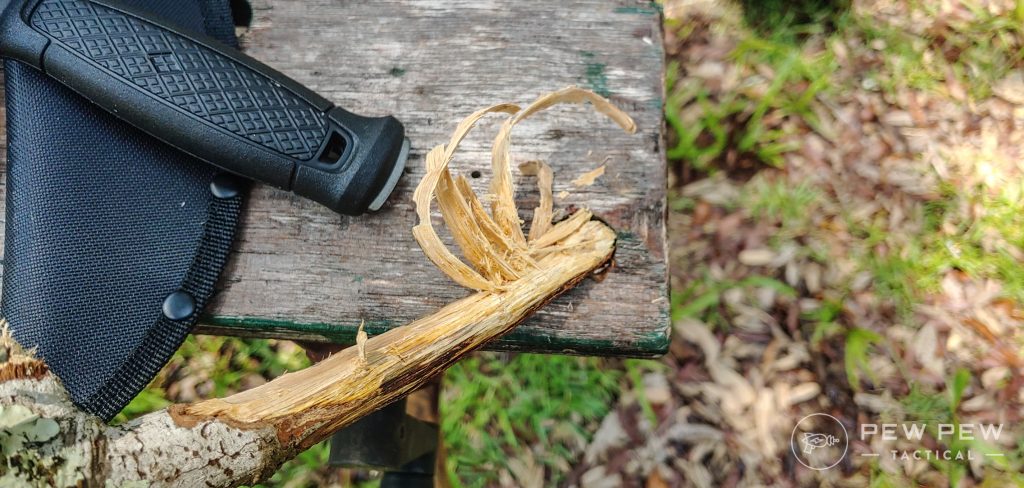
On the other hand, survival skills relate more to short-term needs centered on signaling and obtaining help.
An experienced bushcrafter could survive and even thrive in the great outdoors. In fact, they often enjoy the challenge.
So, with that in mind, are survival knives and bushcraft knives different?
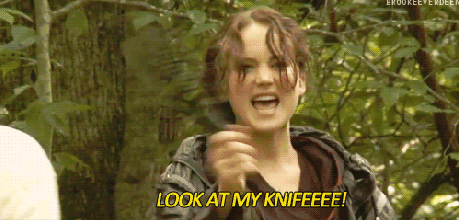
Yes, in many ways, they are…but as you’d imagine, there’s a lot of crossover between the two genres.
Dedicated survival knives tend to be large and heavy knives. They often try to be a knife, a machete, and a hatchet all in one.
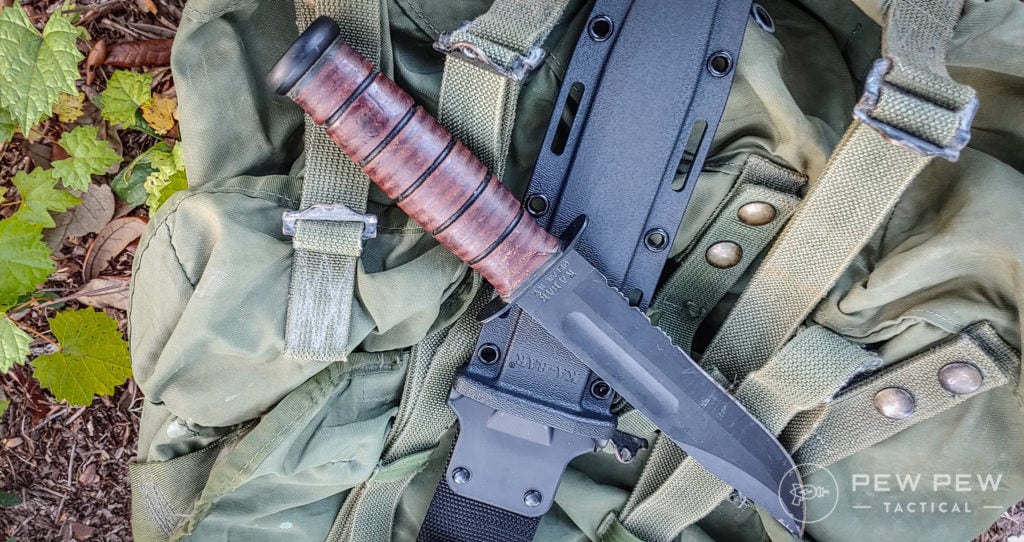
Bushcrafters will bring other tools. If they need a hatchet, they will have a hatchet, a machete, etc.
So, bushcraft knives can be smaller and lighter. They are not relied on for a dozen tasks.
A bushcraft knife is often complimented well by a folding knife or a multitool.
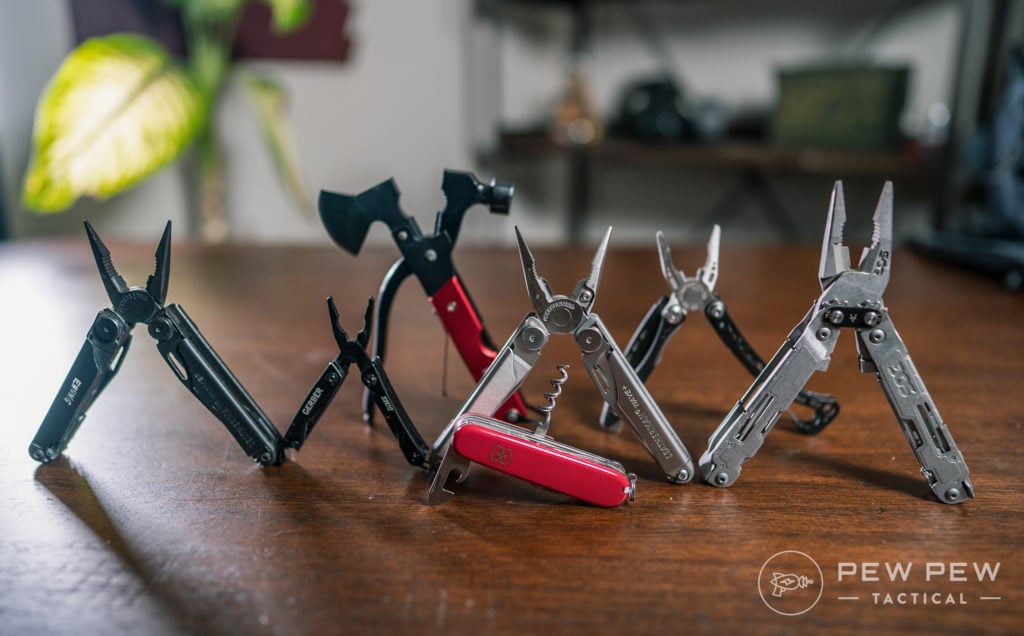
A bushcraft knife is one that can also make tools and should be designed as such.
They can also make kindling, bow drills, pot hooks, spoons, as well as sharpen sticks into points and baton wood.
How to Choose the Best Bushcraft Knife
A dedicated bushcraft knife has a few must-have design features.
These ensure it’s a rugged, investment-worthy knife that will take years of abuse and last.
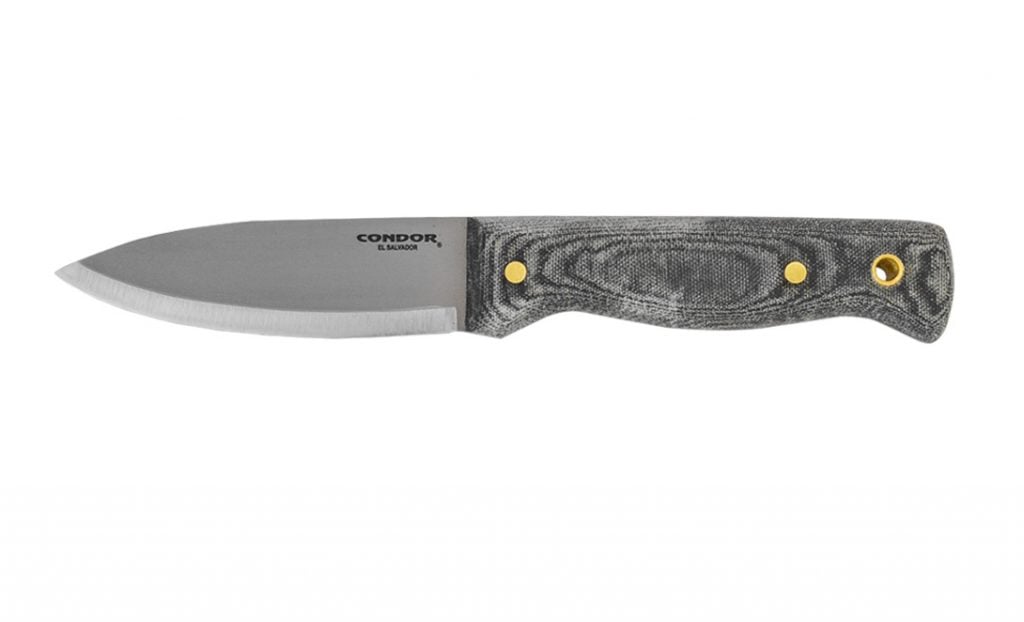
Aside from a durable design, there are a few other characteristics these knives should have, so let’s break those down…
Fixed Blade
Yep, pretty simple…a bushcraft knife should have a fixed blade. Folders can accentuate a bushcraft knife, but for dedicated work, a fixed blade is best.
There are dangers of a lock falling or breaking with a folder — no need to care for internal mechanisms with a fixed blade.
A good fixed-blade knife is always more durable than a folder.
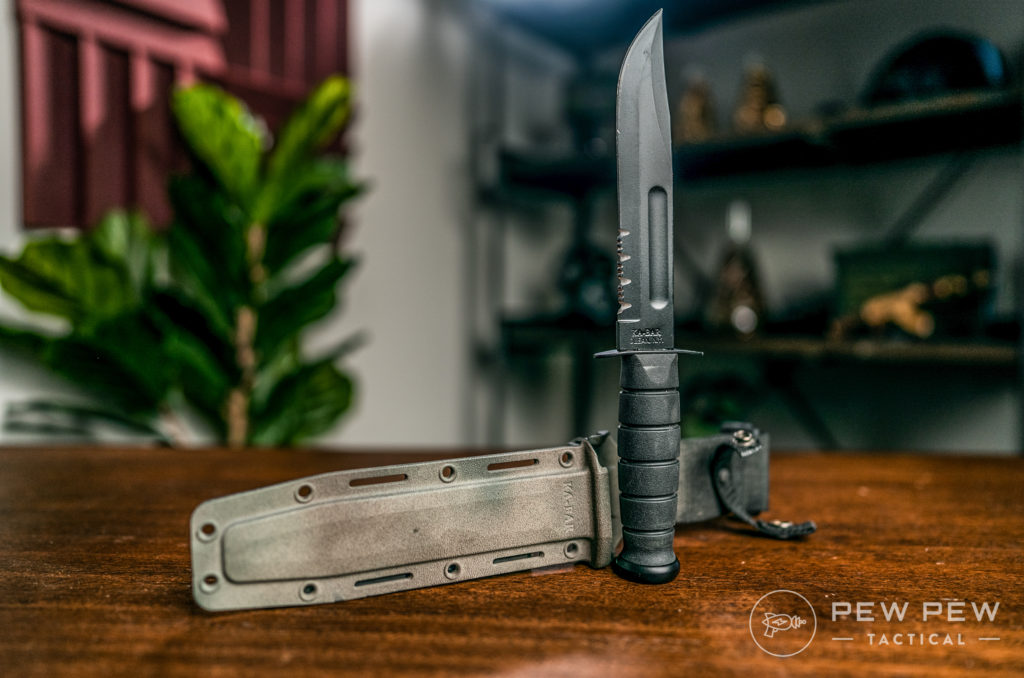
Full Tang Construction
Full tang means the blade and handle are one piece of metal. It offers the most durability.
The handle can be outfitted with grip panels, though, for comfort.
Moderate Length Blade
A big ole Ka-Bar is great when you might need one knife to do it all. But for Bushcraft, it’s just too much.

The longer blades are tougher to control and suck for fine work. A blade length between 3.5- to 5.5-inches works well for bushcraft tasks.
Squared Spine
Squared spines are awesome for various tasks.
It doesn’t need to be perfectly squared like a Morakniv, but it helps. This shape should be squared enough to strike a Ferro Rod to create sparks.
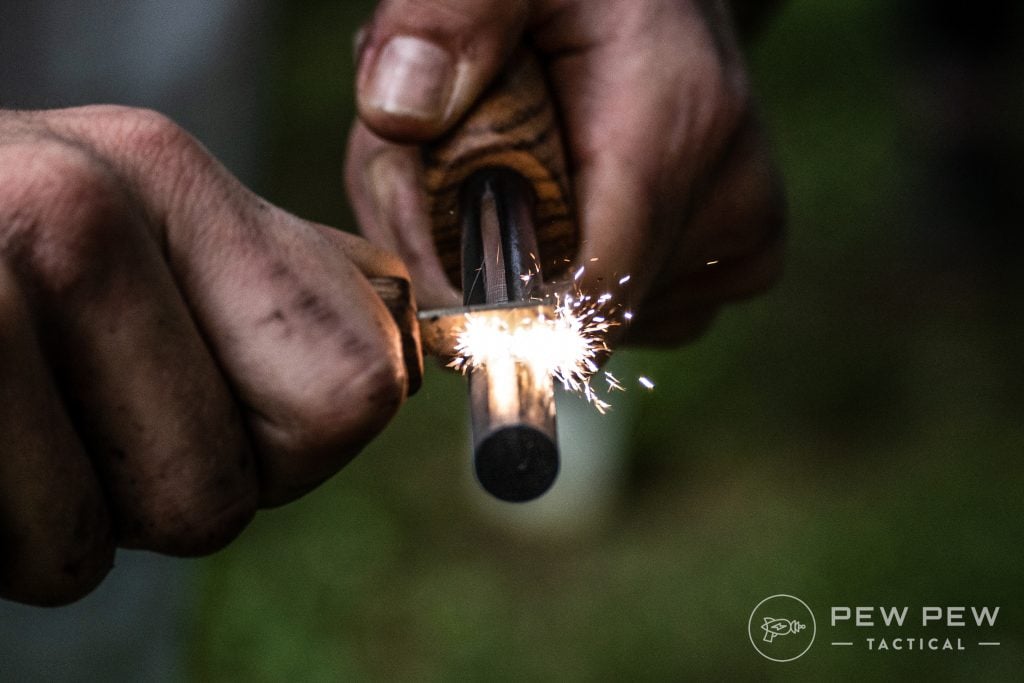
The square spine also makes it easier to baton wood and turn sticks into kindling.
Comfortable Grip
Unlike most other knives, a comfortable grip is a must-have on a bushcraft knife.
You’ll work hours at a time with one, so comfort is critical. A knife that causes hot spots will cause blisters eventually. That’s no fun.

I love my Emerson PUK…the aggressive G10 grips are great for fighting…but not for bushcraft.
You’ll still want a safe grip that clings to your hand, but comfort should be a priority.
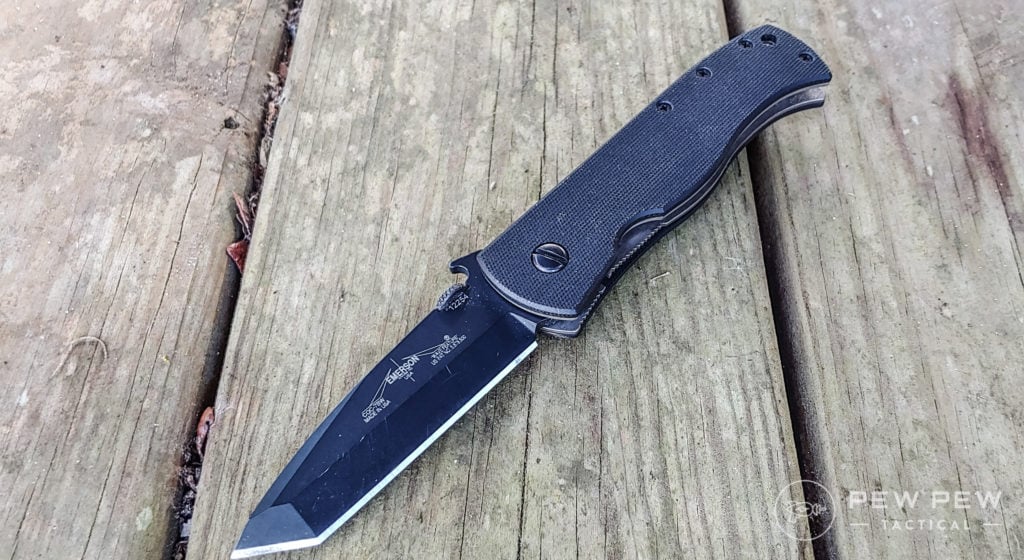
Stainless Steel vs. Carbon Steel?
I don’t want to dive deep too far into this argument because it’s been raging for years. (Kinda reminiscent of 9mm vs. 45 ACP.)
For bushcraft purposes, you can go either way. However, carbon steel works better with striking robs for fire.
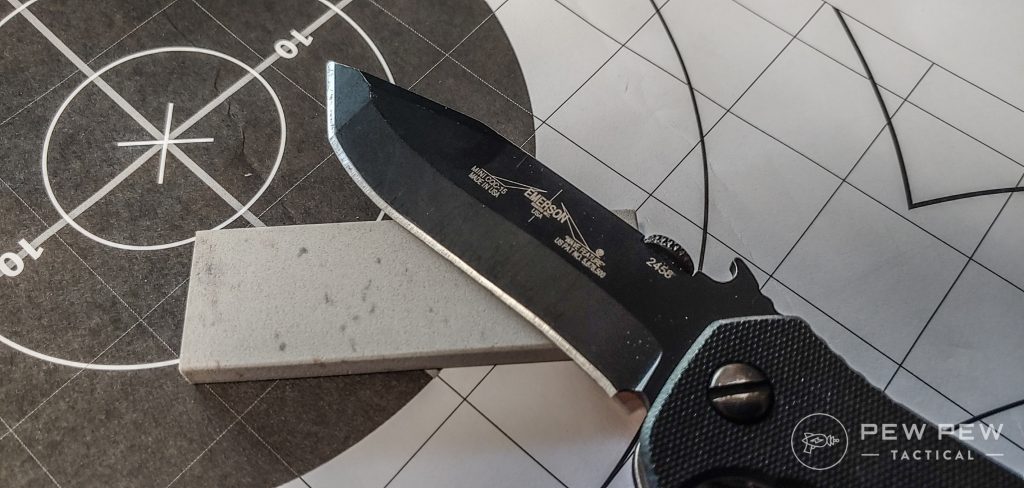
Stainless steel doesn’t rust nearly as fast as carbon steel and requires less maintenance.
Honestly, it’s just best to evaluate your needs, ability to sharpen a knife, and how much time you want to spend maintaining your gear.
Final Thoughts
Bushcrafting can be a fascinating hobby. Admittedly, the skills get rather advanced, requiring lots of patience to master.
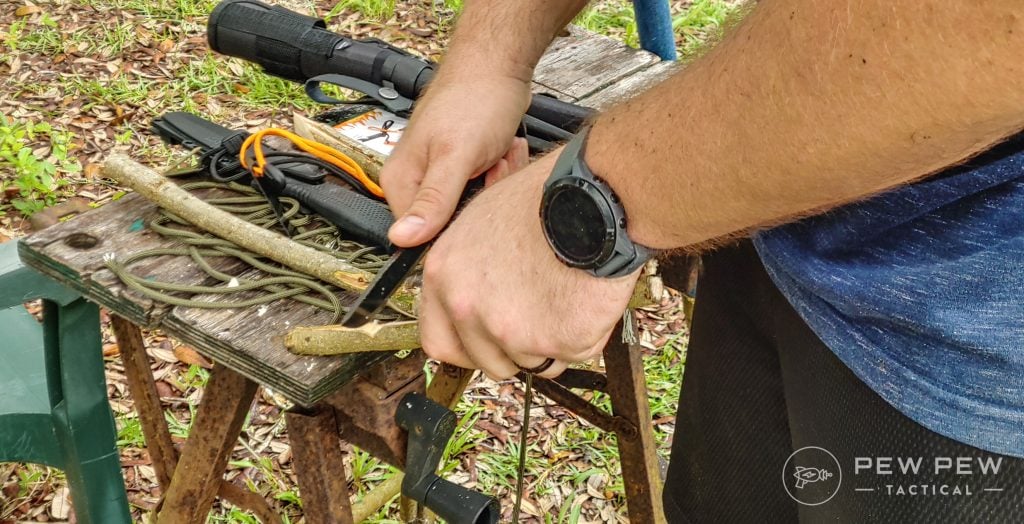
However, you can start with nothing more than a knife and a backyard. And any of these models will do the job.
What’s your preferred bushcraft knife? Let us know below! Ready to dive into more bushcrafting? Check out the 5 Bushcraft Skills You Need to Know.
Latest Updates
April 18, 2024: Moved the number 1 editor’s pick on top. Reorganized the titles. Resized images and updated prices. Added specs chart to make it easier to compare products.

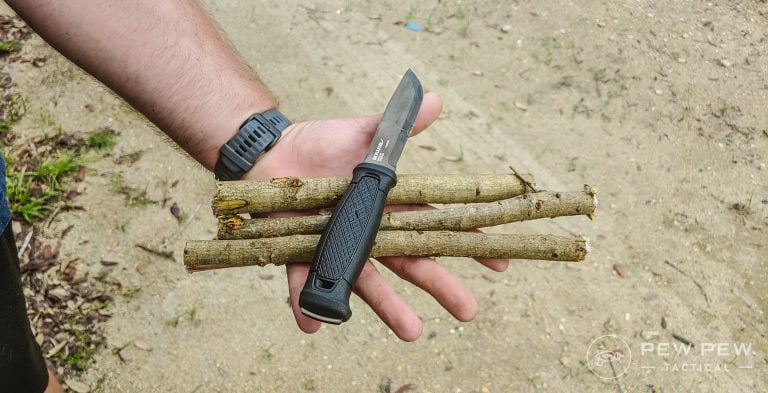



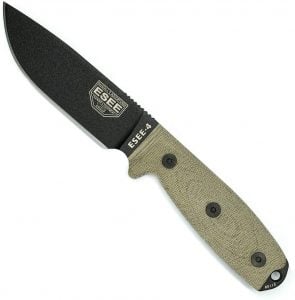


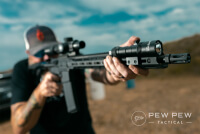


7 Leave a Reply
As disappointing as it may be, the early bushcrafters of the 1900s did recommend a kit of edges, not depending on just one knife. Hatchet, medium knife, long folder was one combination. Goes to what was considered necessary even in Lewis and Clark's day - they took a lot of each for trade goods and their own use. Hatchets, axes and tomahawks were plentiful and common in their journey.
Why baton your only knife in a survival situation - possibly breaking it - when a hatchet would be better? Canadian bush pilots are required by law to take an axe. Only military pilots take just one survival knife, considering there is little else to have on a vest and the odds of a "live" landing in the field are low.
I note there is a divide in blade grind with bushcraft knives, either the full flat - which processes meat better - or the barely ground edge on what appears to be flat stock. Its dominant with North Europe factory offerings and is even seen on their military knives. They also tend to be much lighter blades, which is rarely contrasted with the others.
Bushcraft knives as now sold weren't in the days of pioneering - people working their way west, or moving further from increased civilization had kits of tools, not just one. By forcing many jobs onto one knife, it's much the same as a set of multipliers, it does a lot of things but none well. That's where I part ways with them - BTW, it just dug up my Becker, and it's still a big heavy and blunt chopper but not real good on rabbits. As for handling wood, my old Ames hatchet still works more easily doing the same. I see bushcraft knives not as an answer for how pioneers did do the work, but as a fantasy tool for how people role play doing it now.
Having carried a fixed blade for most of my military career and while hunting, I've found a good field knife - not tactical, but one capable of field dressing deer - to be a good choice. That's a 4" flat grind with drop point, no choil, simple full tang handle that can be gripped by either hand up or down with no hotspots. It cuts - no hammers, or batons, or spears, or whatever. It's a tool for food prep as much as game prep. Simple carbon steel is all that is really needed, I already have the higher alloy on the sharper folding knife, anyway.
That and a light hatchet pretty much covers it. If you do carry a knife, you already know that two is one and one is none, we already know not to carry one way to make fire, but have another, same with a knife.
After searching and scrolling for a pure-quality bushcraft knife for my next tour. A knife attracted me a lot. It is made from high-quality materials, high-grade steel with a pure wooden handle. The sheath is robustly made from well-finished leather. I have been using it for 2 years. I always buy my knives from Almazan Knives. Almazan knives are one of the best sellers for pure quality knives.
I am a HUGE TOPS, Lord and Field, ESEEE, Buck N Bear, Condor and Spyderco fan…. BUT you all really need to check out and add these beauties and beasts too your lists!!
Holtzman’s Gorilla Survival Gear! He has very solid, high quality bushcraft knives and fire starting sets! And so much more! Nathan Holtzman really hits it out of the park and those of us who have had the privilege to own one of his bushcraft survival knives, camping knives, chopper, etc. would love too see his products out there and in more hands! Please check it out on Amazon under Holtzman’s Gorilla Survival Gear or on FB under Prepping & Bushcraft Backwoods to City Survival Community!! You won’t regret it!! Do a review or look up the reviews that have been done. I’m just that confident
I urge everyone buying a knife to buy American.
Bushcraft is building basic shelter and starting fires. (Good luck doing anything else with those wimpy-ass knives.) Have fun pretending matches and lighters don't exist. Enjoy pretending some sticks are enough shelter. Survival is everything else, for which a stouter blade will be necessary. Bushcraft is fine, just don't kid yourself.
If you had any kind of decent reading comprehension skills. You would of read that "bushcrafters" carry other tools like hatches and axes, so a larger knife isnt needed. Unless you're compensating for congenital shortcomings. However, if you only had one tool. A medium sized knife would certainly do more for you, especially a design that lends itself to doing multiple tasks well. A kukri knife or tracker comes to mind. But if you know what you're doing, you can batton smaller knives and use other skills to get big knife work done with a smaller sturdy fixed blade knife.
I’m guessing you missed the part about Bushcraft practitioners taking a hatchet, axe or machete with them to do hatchet, axe and machete work Rambo.